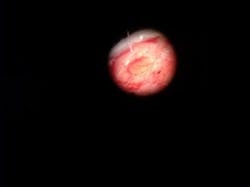Ultrathin optical fiber-based endoscope images neurons firing in living mice
Researchers at the Massachusetts Institute of Technology (MIT; Cambridge, MA) have developed an ultrathin endoscope that can image the activity of neurons in the brains of living mice. The endoscope, which is based on a 125-µm-thick optical fiber, can be pushed deeper into the brain tissue without causing significant damage.
Related: Optics- and photonics-enabled endomicroscopic probes visualize live-cell activity
"In addition to being used in animal studies to help us understand how the brain works, this new endoscope might one day be useful for certain applications in people," says Shay Ohayon, who developed the device as a postdoctoral researcher in James DiCarlo's lab at MIT. "It could offer a smaller, and thus more comfortable, instrument for imaging within the nasal cavity, for example."
"With further development, the new microendoscope could be used to image neuron activity in previously inaccessible parts of the brain such as the visual cortex of primate animal models," Ohayon says. "It might also be used to study how neurons from different regions of the brain communicate with each other."
The microendoscope is based on a multimode optical fiber that can carry different multiple beams of light at the same time. When light enters the fiber, it can be manipulated to generate a tiny spot at the other end, and can be moved to different positions on the tissue without moving the fiber. Scanning the tiny spot across the sample allows it to excite fluorescent molecules used to label neuron activity. As the fluorescence from each spot travels back through the fiber, an image of neuron activity is formed.
"To achieve scanning fast enough to image neurons firing, we used an optical component known as a digital mirror device (DMD) to quickly move the light spot," Ohayon says. "We developed a technique that allowed us to use the DMD to scan light at speeds up to 20 kHz, which is fast enough to see fluorescence from active neurons."
Because the multimode fibers used for the endoscope scramble light, the researchers applied a method called wavefront shaping to convert the scrambled light into images. For wavefront shaping, they sent various patterns of light through the fiber to a camera at the other end and recorded exactly how that specific fiber changed light that passed through. The camera was then removed, and the fiber placed into the brain for imaging. The previously obtained information about how the fiber changes the light is then used to generate and scan a small point across the field of view.
The researchers then tested their microendoscope on anesthetized mice. They inserted the fiber through a tiny hole in the skull of a mouse and slowly lowered it into the brain. To image the neurons firing, the researchers used a technique called calcium imaging that creates fluorescence in response to the influx of calcium that occurs when a neuron fires. "One of the advantages of using an endoscope so thin is that as you lower it into the brain, you can see all the blood vessels and navigate the fiber to avoid hitting them," Ohayon says.
In addition to showing that their endoscope could catch detailed neuronal activity the researchers also demonstrated that multiple colors of light could be used for imaging. This capability could be used to observe interactions between two groups of neurons each labeled with a different color, for example.
For standard imaging, the endoscope images the neurons at the very tip of the fiber. However, the researchers also showed that the microendoscope could image up to about 100 µm away from the tip. "This is very useful because when the fiber is inserted into the brain, it may affect the function of neurons very close to the fiber," Ohayon explains. "Imaging an area slightly away from the fiber makes it easier to capture healthy neurons."
One limitation of the microendoscope is that any bends in the fiber cause it to lose the ability to produce images. Although this didn't affect the experiments described in the researchers' paper because the fiber was kept straight as it was pushed into the brain, solving the bending problem could greatly expand the applications for the device. Various research groups are working on new types of fibers that are less susceptible to bending and computational methods that might compensate for bending in real time.
"If this bending problem can be solved, it will likely change the way endoscopy in people is performed by allowing much thinner probes to be used," Ohayon says. "This would allow more comfortable imaging than today's large endoscopes and may enable imaging in parts of the body that aren't currently feasible."
Full details of the work appear in the journal Biomedical Optics Express.
